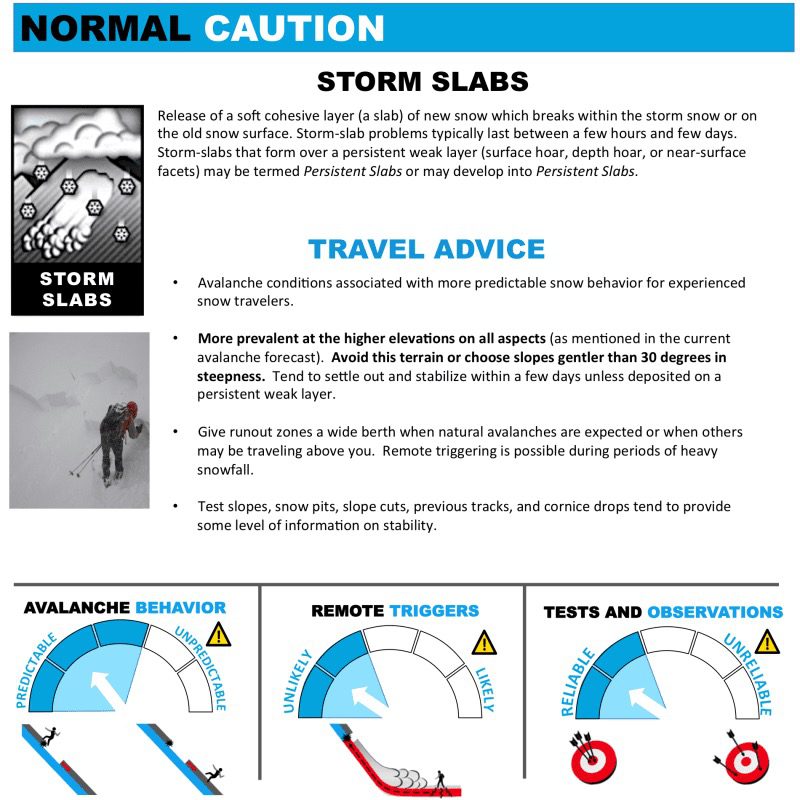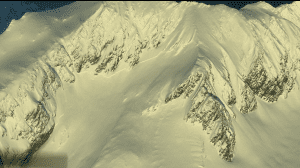Haines Avalanche Center
Above 2,500ftConsiderable
1,500 to 2,500ftConsiderable
Below 1,500ftLow
The Avy Rose shows the forecasted danger by elevation and aspect. It adds more detail about where you are likely to find the dangers mentioned in the forecast. The inner circle shows upper elevations (mountain top), the second circle is middle elevations, and the outer circle represents lower elevations. Think of the Rose as a birds-eye view of a mountain, looking down from above. The rose allows our forecasters to visually show you which parts of the mountain they are most concerned about.
Degrees of Avalanche Danger
Avalanche Problems
Problem 1
Aspect: SW-N-E Aspects
Elevation: Near and Above Tree line
Bottom Line: The last 5 days have seen a “lock up” of our snowpack to ~4,000′. This has led to a creation of a firm bed surface for the new storm snow to slide on. The formation of isolated surface hoar and near surface facets over the last several days have formed weak snow at the top of the snowpack. New storm snow will likely not bond well between the old and new snow interface, creating instabilities near the surface. Natural avalanches are possible and human triggered avalanches are likely on leeward slopes (slopes opposite of the prevailing wind – see Avalanche Rose) near and above tree line. With freezing levels between 500-1000′, higher snowfall amounts are predicted further into the alpine, increasing the risk of being caught in a larger avalanche. Be aware that weak layers still exist deeper in the snowpack, but they are difficult to trigger as a firm surface and hard crusts above the suspect layers are supportable and reduce the chance of triggering one of these weak layers.
Travel Advice:
- Look, listen and feel for shooting cracks and collapses within the new storm snow.
- Use caution when approaching steep, convex rollovers as this is a likely failure point.
- Avoid leeward areas where the new storm snow will be blown and accumulate higher snowfall totals.
- Avoid terrain trap areas such as cliffs and gullies, and areas where it is hard to escape off to the side.
- These avalanches will likely fail on the new/old snow interface. It should be quite easy to tell where this interface is as it is a hard and firm bed surface.
- Storm slabs have soft slab properties, making the potential for propagation much wider than expected over the hard bed surface.

Likelihood:
- Almost Certain
- Very Likely
- Likely
- Possible
- Unlikely
Size:
- Historic
- Very Large
- Large
- Small
Trend
- Increasing
- Steady
- Decreasing
Avalanche Activity
From 1/29 to 2/1, several reports came in of recent avalanches in the alpine. The common characteristics of these slides were wide propagation, and failing 2-5ft deep at the interface below the wind slabs from last week’s atmospheric river. We have strong reason to suspect these slides occurred on a buried surface hoar layer from 1/20. They happened on all aspects, at elevations from 3000 – 5000ft, and all were in wind sheltered areas below ridges, features, and starting zones. Slide were observed in the Transitional and Lutak zones.
4Winds zone. SW. 4000-5000′
Near Mt. Kraus
The confluence of the Boundary and Saksaia glaciers above Glacier Creek. N. ~4700′
Weather
Forecast:
A small front will make its way in on Thursday with up to 12” of new snow in the alpine. Lower amounts of 3-6” above the freezing line. Snow levels 500-1000′. Rain showers near town with scattered snow showers turning to rain in the afternoon out the highway. Temps in the 30s with Strong South winds.
Seasonal Summary:
- Feb 12-14th had freeze/thaw cycles that locked up the snowpack to ~4,000′.
- Feb 5th-9th brought snow levels near 3,500ft, and 2.5-4″ of SWE with strong south winds.
- Feb 1st-4th brought in 12-24″ of low density powder.
- Jan 27-29 brought 1.5 – 2.4″ of SWE with freezing levels near 1500ft.
- An Atmospheric river hit Jan 21-22. It brought in 2-7″ of SWE (2-5ft of snow above 2500ft, mostly rain below)
- Jan 9th-15th brought 24-48″ of new snow in the alpine, with some light rain up to 3,500ft, followed by heavier rain up to 2000ft.
- Very strong NW winds and arctic temperatures blasted the area the first week of January.
- Jan 1st: New snow (20″ in Lutak, 7″ Transitional zone) buried any preserved surface hoar.
- Moderate NW winds hit exposed slopes Dec 19-20th.
- Surface hoar formed on all aspects and elevations Dec 17-18th.
- December brought in about 2-5 feet of snowfall (highest in Lutak zone), and a few strong NW wind events.
- November brought consistent heavy snowfalls, cold weather, and SE winds.
- October brought heavy snow in the alpine, followed by a few rain/sun crusts.
| Snow Depth [in] | Last 24-hr Snow/SWE [in] | Last 3-days Snow/SWE [in] | Today’s Freezing Level [ft] | Today’s Winds | Next 24-hr Snow/SWE | |
| Mount Ripinsky @ treeline ** | 122″* | 2″ / 0.1″* | 2″ / 0.1″* | 500′ – 1,000′ | Strong, S | 12″ / 1.0″* |
| Flower Mountain @ treeline | 69″ | 2″ / 0.1″ | 2″ / 0.1″ | 500′ – 1,000′ | Strong, S | 12″ / 1.0″ |
| Chilkat Pass @ 3,100ft | 31″ | 12″ / 1.3″ | 12″ / 1.3″ | 0′ | Light, SE | 4″ / 0.04″ |
( *star means meteorological estimate )
** The Ripinsky weather station is in need of repair, and will likely be down until Summer.
Additional Information
Safe backcountry travel requires training and experience. You control your own risk by choosing where, when and how you travel. Ride rescue ready. Be prepared for an emergency. Prevent hypothermia. Carry bear spray. Winter is a high consequence environment.
Become a sustaining Haines Avalanche Center Member by clicking the poster or visiting dev.alaskasnow.org/joinHAC. Support local forecasts, observations, education and weather stations. Join a community of winter recreationalists. Benefit from collective knowledge and skills. Help keep your friends and family safe in the backcountry. Get a free limited edition mountain buff, or neck gaiter with a $50 membership (first 20 members!).
Practice like you play. Make sure all your rescue gear is fully functional and your beacon has NEW batteries. Make sure 1) everyone in the group has a functioning beacon, shovel and probe 2) knows how to use them and 3) has trained in companion rescue in the last year. Keep your skills fresh. If you head into the hills, watch out for red flag avalanche conditions, natural avalanches, whoomphing or collapsing, and shooting cracks.
Education Video Links:
- AIARE
- How to Practice Avalanche Rescue Snowmobile Edition: https://youtu.be/2ML499MMDfM
- AK Sled Shed Motorized Learning:
- Intro: https://youtu.be/aoagKHfGkxs
- Personal Electronics in Avalanche Terrain: https://youtu.be/2Vz9S0OEyFk
- Snowmobile Macgyver Tool Kit: https://youtu.be/4WBNu_t6Bbk
- Head and Face Protection: https://youtu.be/jIzW89wOyZI
- Pre-season prep: https://youtu.be/zJmrb8cZlR4
- My Transceiver: https://youtu.be/yblaDWP7Jf8
- BCA Avalanche Safety for Snowmobilers
- How to Fix Common Snowmobile Problems in the Field: https://youtu.be/g9fiTxEvuFk
- Sleducation: Avalanche Safety for Snowmobilers: https://youtu.be/EWFOd_9DYb8
- Intro to Avalanche Transceivers for Snowmobilers: https://youtu.be/6ZLSBmsceog
- Avalanche Transceiver Trailhead Test for Snowmobilers: https://youtu.be/rWoXbadFBsY
- Avalanche Transceiver Searching Use Snowmobiles: https://youtu.be/w1ucyI6LMXM
- BCA Avalanche Rescue Series
- Beacon Search 101: https://youtu.be/nnHXLVA2FcE
- Avalanche Probing 101: https://youtu.be/-0_yDN5Drzw
- Avalanche Shoveling 101: https://youtu.be/dGQg9o3vAkM
- Organizing a Backcountry Rescue: https://youtu.be/gywtmukgt8s
- Post Avalanche Patient Care: https://youtu.be/9FyIeUy4wpQ
- Backcountry Evacuation: https://youtu.be/WPF-dciefL8
- Complex Multiple Burials Backup Techniques: https://youtu.be/pB6AfY2KyYo
- National Avalanche Center
- Avalanche Problems Explained: https://youtu.be/DkbnT_9-cHU
- Intro to North American Avalanche Danger Scale: https://youtu.be/r_-KpOu7tbA
Announcements
Click the +Full Forecast button below to read the details. Please submit your observations if you head out!




